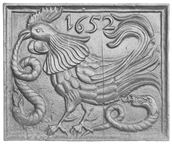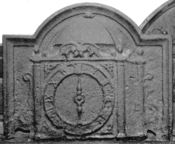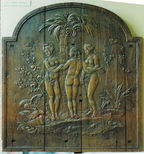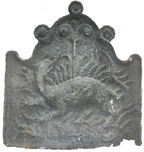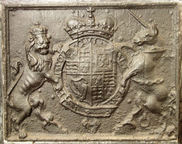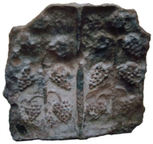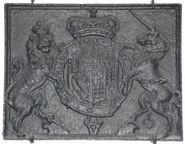-
651
Description: Rectangular; cavetto edging; a left-facing cockerel grasps a snake in its beak, another snake writhes on the ground behind it; date to left of the cockerel’s tail; four vertical planklines.
Notes: The design may have religious significance, the snake symbolising sin and the cockerel denoting St Peter’s denial of Christ. The ‘1’ of the date is hooked, suggesting a common source with firebacks designed by the pattern-maker, IM. A copy of this fireback is set into the brickwork of 16 Old Church Street, Chelsea, London.
Copies of this fireback are known.
Inscription: 1652
- Decoration tags:
- rectangular (shape)
- cavetto (edging)
- whole carved pattern
- planklines
- pictorial
- biblical
- text
- animals
Manufactured: in 1652 possibly at Brede Furnace in the Weald area of England.
Current location: not known.
- Attached to series:
- Small cavetto series
- Hooked '1' series
- New Testament firebacks
- Brede group
-
119
Description: Arched rectangular shape; cavetto moulded edge on all sides; perspective view of a lantern clock.
Notes: The arms of the Worshipful Company of Clockmakers were granted in 1672: Sable a Clock each of the four pillars of the case based on a Lion couchant and capped with a Globe surmounted by a Cross and on the dome of the case an Imperial Crown all Or. The hands of the clock show six o’clock, as on the livery company shield. Formerly part of the Ade Collection (from Grove Hill, Hellingly, Sussex).
Copies of this fireback are known.
- Decoration tags:
- rectangular with round arch (shape)
- cavetto (edging)
- whole carved pattern
- objects
Manufactured: in the mid-17th century in the Weald area of England.
Current location: Hastings Museum and Art Gallery, John's Place, Bohemia Road, Hastings, East Sussex, England.
Museum number: HASMG: 1952.51.48 (LA 776) (part of the Hastings Museum museum group)
- Attached to series:
- Small cavetto series
- Livery company firebacks
-
934
Description: Carved wooden fireback pattern. Arched rectangular shape with fillet and astragal edging; pictorial scene of The Three Graces in an exotic rural setting, with a palm tree, roses and ?doves.
Notes: The detail of the carving is very fine
- Decoration tags:
- rectangular with round arch (shape)
- fillet (edging)
- whole carved pattern
- planklines
- pictorial
- mythological
- humans
- plants
- objects
Manufactured: in the 18th century in France.
Current location: Haardplatenmuseum Klarenbeek, Oude Broekstraat 12, Klarenbeek, Netherlands.
- Attached to series:
- Patterns
-
891
Description: Quasi-arched rectangular shaped; unique, cavetto-moulded edging, which loops upon itself three times. A mythical salamander shown in the flames which legend states it is able to resist; behind is what appears to be a palm tree.
Notes: Other known variants are dated; this variant confirms that the dates were added to subsequent castings. Corrosion to the bottom right corner may have obliterated a letter 'M' seen on another casting; presumably part of 'IM'.
- Decoration tags:
- rectangular with ornate arch (shape)
- cavetto (edging)
- whole carved pattern
- pictorial
- mythological
- animals
Manufactured: in the mid-17th century possibly at Brede Furnace in the Weald area of England.
Current location: not known.
Citation: Schubert, H. R., 1957, 'A Forgery in Iron', Journal of the Iron & Steel Institute, 165, p. 125.
- Attached to series:
- Hooked '1' series
- Loop edged firebacks
- Brede group
-
593
Description: Rectangular, cavetto moulded edging; Stuart royal shield, garter, supporters and crown.
Notes: Four clear vertical plank lines indicate that the pattern for this fireback was formed of a series of boards probably secured by horizontal battens on the rear.
Copies of this fireback are known.
Inscription: HONI SOIT QVI MAL Y PENSE
Arms: English Stuart royal
- Decoration tags:
- rectangular (shape)
- cavetto (edging)
- whole carved pattern
- planklines
- armorial
- royal
- text
Manufactured: in the late-17th century in England.
Current location: Ham House, Richmond, Surrey, England.
Museum number: 1140118 (part of the National Trust museum group)
- Attached to series:
- Stuart royal armorial firebacks
-
847
Description: Originally rectangular; two identical panels, each with braid edging, a vine standard with six bunches of grapes and a cluster at the top.
Notes: One of an unusual series formed from separate panels arranged, in this instance, with repeated panel; fire-damaged, hence the distorted shape. Recovered after the fire at Nymans, Handcross, Sussex in 1947.
- Decoration tags:
- rectangular (shape)
- simulated rope (edging)
- carved pattern panels
- plants
Manufactured: in the late-16th century in the Weald area of England.
Current location: not known.
- Attached to series:
- Armada series
-
731
Description: Rectangular with flanged edging and a moulded frame; pictorial scene of the Marriage at Cana in an architectural setting; inscription along bottom edge.
Notes: The pattern-maker is believed to be Master Ronnung.
Inscription: HISTORIA VON DER HOCHZEIT ZV CANA IN GALILEA ...
- Decoration tags:
- rectangular (shape)
- flanged (edging)
- whole carved pattern
- pictorial
- biblical
- text
- humans
- objects
Manufactured: in the late-16th century possibly in the Harz area of Germany.
Current location: Victoria & Albert Museum, Cromwell Road, Kensington & Chelsea, Greater London, England.
Museum number: 319.1897 (part of the Victoria & Albert Museum museum group)
Citation: Dawson, C., 1903, 'Sussex Iron Work and Pottery', Sussex Archaeological Collections, 46, pp. 1-54.
Citation: Gardner, J. S., 1898, 'Iron Casting in the Weald', Archaeologia, 56, 1, pp. 133-164.
- Attached to series:
- Stoveplates
- Marriage at Cana stoveplates
-
751
Description: Rectangular, cavetto moulded edging; Stuart royal shield, garter, supporters and crown.
Notes: One clear vertical plank line indicate that the pattern for this fireback was formed of a series of boards probably secured by horizontal battens on the rear.
Copies of this fireback are known.
Inscription: HONI SOIT QVI MAL Y PENSE
Arms: English Stuart royal
- Decoration tags:
- rectangular (shape)
- cavetto (edging)
- whole carved pattern
- planklines
- armorial
- royal
- text
Manufactured: in the mid- to late-17th century in England.
Current location: Victoria & Albert Museum, Cromwell Road, Kensington & Chelsea, Greater London, England.
Museum number: 432.1896 (part of the Victoria & Albert Museum museum group)
- Attached to series:
- Stuart royal armorial firebacks
